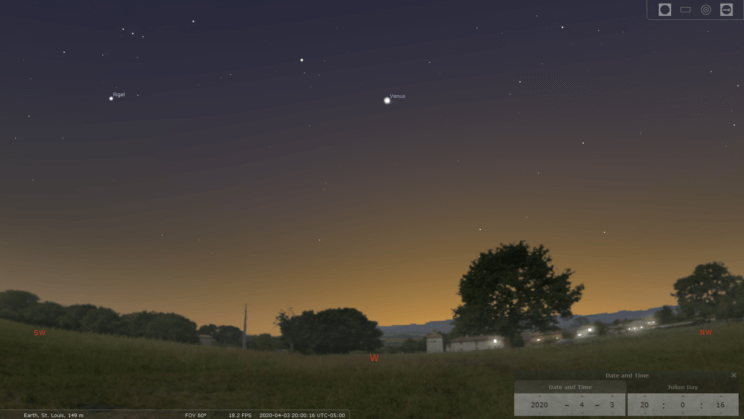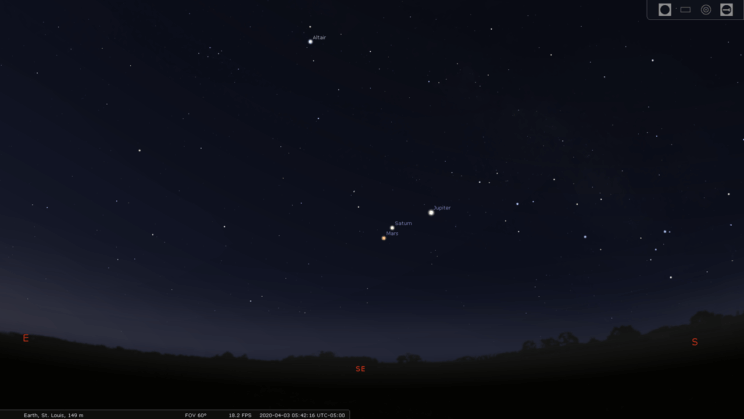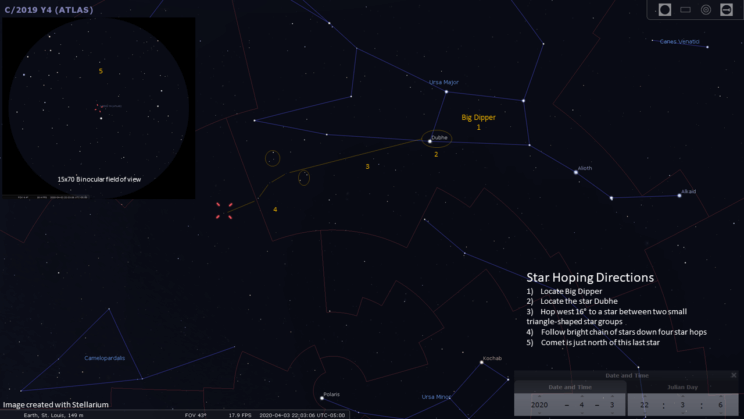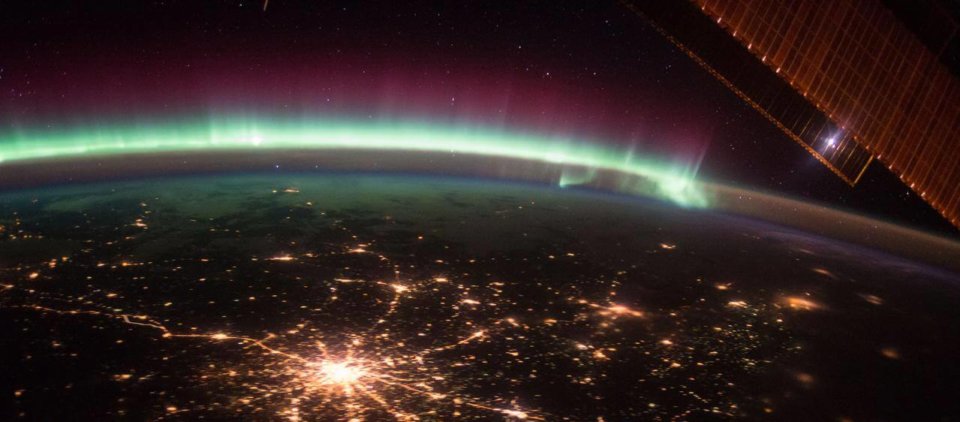This is the Saint Louis Science Center’s NIGHT SKY UPDATE for the week of Friday, April 3, 2020.
Information updated weekly or as needed.
Times given as local St. Louis time (CDT). For definitions of terminology used in the night sky update, click the highlighted text.
Our next star party scheduled for Friday, April 3, 2020 has been canceled due to recommendations from the CDC regarding COVID-19. All public telescope events are canceled until further notice. As conditions change, we will reevaluate and this article will be updated once these events resume.
The Sun and Moon

The Moon as seen from the International Space Station, on July 31, 2011.
Credit: NASA
Sunrise is at 6:42 a.m. on Friday, April 3 and sunset is at 7:27 p.m. providing us with about 12.5 hours of daylight. Even after sunset, the light from the Sun will still dimly illuminate our sky for about 1.5 hours. This period is called twilight, which ends around 8:59 p.m. this week. For those with a sundial, solar transit or local noon occurs around 1:04 p.m. this week.
| Day | Sunrise | Sunset |
| 03 Apr | 6:42 a.m. | 7:27 p.m. |
| 04 Apr | 6:40 a.m. | 7:28 p.m. |
| 05 Apr | 6:39 a.m. | 7:29 p.m. |
| 06 Apr | 6:37 a.m. | 7:30 p.m. |
| 07 Apr | 6:36 a.m. | 7:31 p.m. |
| 08 Apr | 6:34 a.m. | 7:32 p.m. |
| 09 Apr | 6:33 a.m. | 7:33 p.m. |
| 10 Apr | 6:31 a.m. | 7:34 p.m. |
| 11 Apr | 6:30 a.m. | 7:35 p.m. |
Moonrise for Friday, April 3 occurs at 2:17 p.m. and moonset will occur at 4:53 a.m. on the following day. On Friday, April 3 the Moon will be exhibiting a waxing gibbous phase with roughly 56% of the lunar disk illuminated. Full Moon occurs on April 7. April’s full Moon is often called the Full Pink Moon.
International Space Station (ISS)

Credit: NASA
Visible passes of ISS from St. Louis for the week of April 3 occur during evening hours. The best of these occur on the evenings of April 4 and 5. Use the table below for information about these and other visible passes of ISS.
Catch ISS from St. Louis starting Friday, April 3
| Date | Mag | Starts | Max. altitude | Ends | ||||||
| Time | Alt. | Az. | Time | Alt. | Az. | Time | Alt. | Az. | ||
| 03 Apr | -2.4 | 20:13:42 | 10 | NNW | 20:16:38 | 27 | NNE | 20:18:50 | 15 | E |
| 03 Apr | -1.2 | 21:50:24 | 10 | WNW | 21:51:49 | 21 | W | 21:51:49 | 21 | W |
| 04 Apr | -3.6 | 21:02:48 | 10 | WNW | 21:06:06 | 62 | SW | 21:06:29 | 56 | S |
| 05 Apr | -3.8 | 20:15:20 | 10 | NW | 20:18:41 | 73 | NE | 20:21:14 | 16 | ESE |
| 06 Apr | -1.5 | 21:05:20 | 10 | W | 21:07:46 | 19 | SW | 21:09:04 | 15 | SSW |
| 07 Apr | -2.3 | 20:17:22 | 10 | WNW | 20:20:26 | 33 | SW | 20:23:28 | 10 | SSE |
Magnitude (Mag): The Measure of brightness for a celestial object. The lower the value is, the brighter the object will be.
Altitude (Alt): The angle of a celestial object measured upwards from the observer’s horizon.
Azimuth (Az): The direction of a celestial object, measured clockwise from an observer’s location with north being 0°, east being 90°, south being 180° and west being 270°.
For information about ISS flyovers and other visible satellites, visit www.heavens-above.com
Detailed information regarding all unmanned exploration of our universe, missions past, present, and planned, can be found at Jet Propulsion Laboratories:
The Visible Planets

Looking West, 8:00 pm, April 3, 2020
Credit: Stellarium, EG

Looking Southeast, 5:40 am, April 3, 2020
Credit: Stellarium, EG
This week, four naked eye planets are visible. Venus will be visible in the west just after sunset. Mars, Jupiter and Saturn are visible in the southeast about 2 hours before sunrise. About 45 minutes before sunrise Mercury will be above the horizon but It is too low to be seen with the growing twilight glare of the Sun.
Venus
The brightest planet in the sky is visible as the sunsets. It will be seen high in the west as the sun is setting. Venus reached maximum elongation for its current apparition, because of this Venus will set earlier each night as it heads towards inferior conjunction on June 3, 2020.
Mars
The red planet rises around 3:41 a.m. and will be high enough to see in the southeast by 4:30 a.m. Opposition for Mars occurs on October 13, 2020. As we head towards this date Mars will appear brighter and its surface will eventually be visible through a telescope.
Jupiter
The king of the planets is rising around 3:11 a.m. and should be visible in the southeast around 4:00 a.m.
Saturn
Saturn is rising around 3:32 a.m. Like Jupiter you will need a clear sky to the southeast to catch the ring planet around 4:30 a.m. Later this year Jupiter and Saturn will reach conjunction on December 21, 2020. You can track these planets as they appear to chase one another throughout the rest of this year.
2020 Great Conjunction
This year, the planets Jupiter and Saturn will reach conjunction. A conjunction is when two or more celestial bodies share the same right ascension. For Jupiter and Saturn, this astronomical event only occurs every 20 years. The conjunction will occur on December 21, 2020. You will find the two planets close together in the southwestern sky just after sunset on this date.
Comet C/2019 Y4 ATLAS

Comet C/2019 Y4 ATLAS was discovered in images from a robotic telescope survey called ATLAS (Asteroid Terrestrial-impact Last Alert System). This instrument consists of two 0.5-meter telescopes that each clear night observes a quarter of the observable sky looking for moving objects. The intention is to identify Near-Earth Objects (NEOs). Currently this survey has discovered 430 Near-Earth Asteroids, 44 Potentially Hazardous Asteroids, 37 Comets and 5464 Supernovae. Supernovae are not what would be considered moving objects but are a bonus science objective the program contributes to.
Many northern hemisphere observers are hopeful that Comet C/2019 Y4 ATLAS will become our next great comet. Unfortunately, it is difficult to predict how bright comets will become. Over the past few decades there have been comets that received great hype but turned out to be duds. One of the best examples from recent times is Comet ISON or C/2012 S1. This was a sun grazing comet that was predicted to possibly be as bright as the full moon after its perihelion. Unfortunately, the comet disintegrated and never became the bright comet observers hoped for. It may be exciting to hear the C/2019 Y4 ATLAS could reach -5 magnitude but remember this is just a possibility.
Currently, the apparent magnitude of Comet C/2019 Y4 ATLAS is being reported at roughly 8th magnitude. This puts the comet within reach of backyard telescopes and some binoculars. It is important to remember that even at this magnitude it remains a challenging target in light polluted skies. Comet C/2019 Y4 ATLAS is currently located in the constellation Camelopardalis. This is a circumpolar constellation that is visible all night long. Due to its star being faint, Camelopardalis is a difficult constellation to see. The best way to find Camelopardalis is to locate the Big Dipper and then look west.
For star hoping directions to the comet use the image below. Keep in mind each day the comet’s position will change. If you want an up to date location, you can use the free planetarium software Stellarium.
Current attempts to locate the comet by this author have been unsuccessful due to light pollution. As we head towards Comet C/2019 Y4 ATLAS’s closest approach to Earth on May 23, 2020, we will continue to update the current magnitude of this comet in the night sky update. If you would like more information on Comet C/2019 Y4 ATLAS visit https://www.slsc.org/comet-atlas/

Visit the James S. McDonnell Planetarium for more information on what’s up!
Night Sky Update: April 3-April 10, 2020






